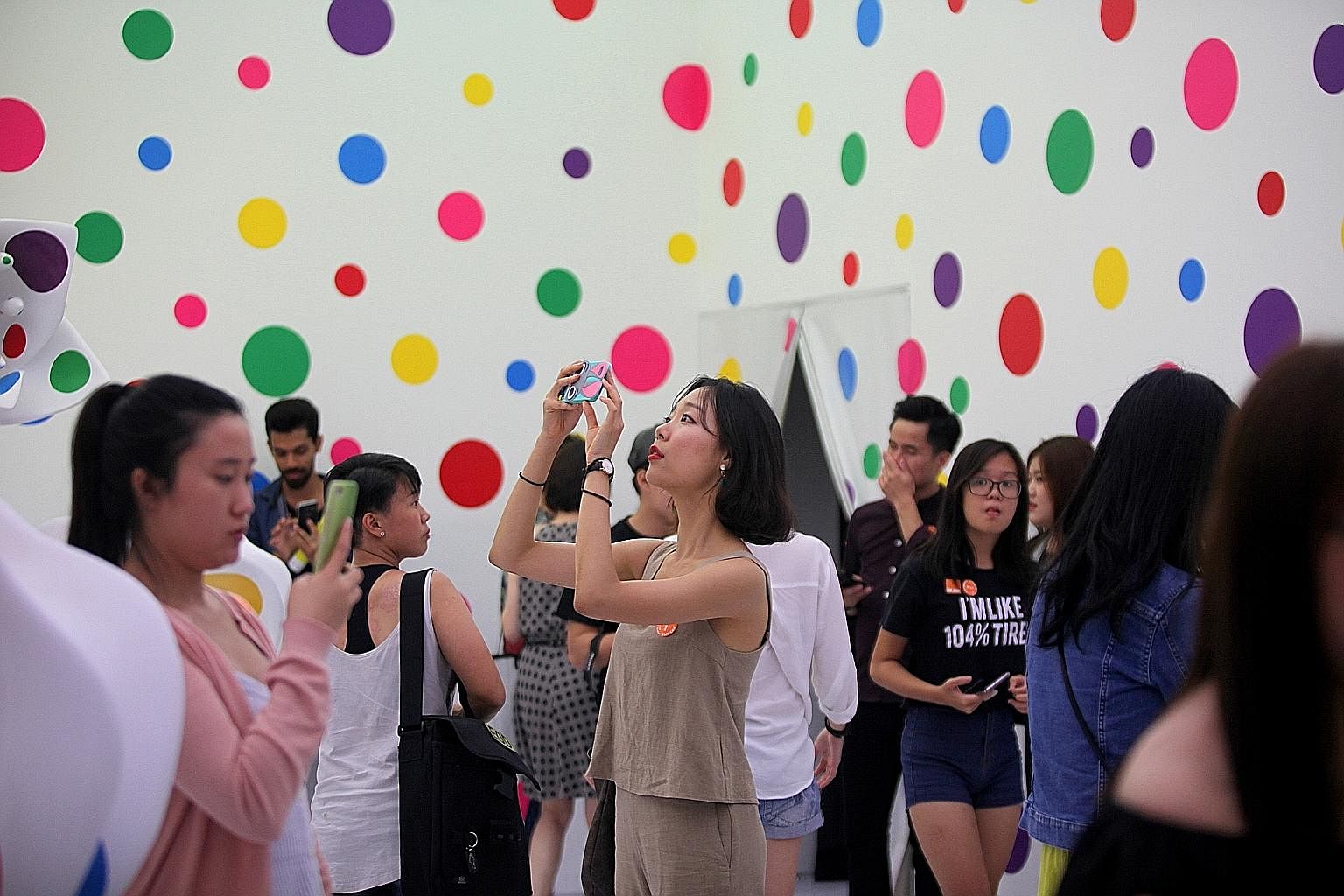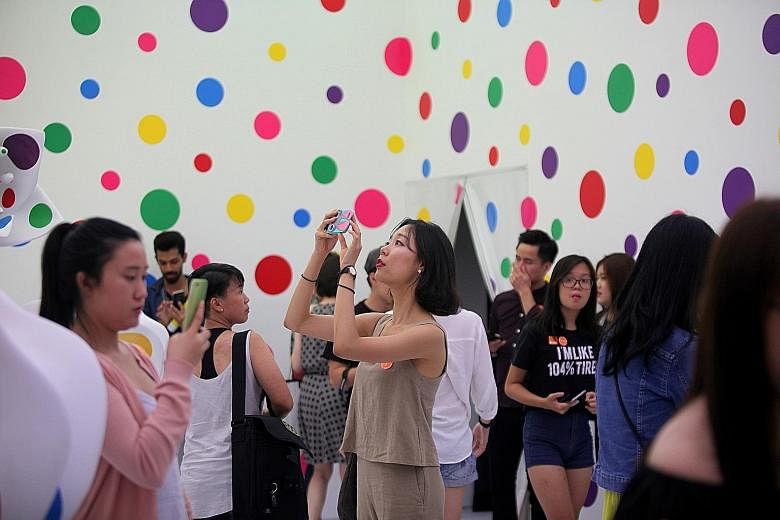I was one of many excited visitors to the highly anticipated exhibition by Japanese artist Yayoi Kusama, Life Is The Heart Of A Rainbow, when it came to the National Gallery earlier this year.
The blockbuster show ran from June to September, drawing more than 235,000 visitors in total. When I visited it with a friend, we had to queue to get into practically every single exhibition hall, and squeeze our way around other visitors so as to ooh and ahh and, yes, take many, many photos of the artworks.
The show caused a stir, not only because of the crowds that flocked to it but also for the intense debate it sparked online about the role of art in this age of social media.
It was an intensely photographable show. Instagram exploded with almost 13,000 photos tagged #sgloveskusama, which comprised the gamut of selfies, wefies, posed shots and static display shots.
And conversely, there was a corresponding bitterness among those who felt they were cheated of a chance to experience the artwork in their own time because they had to contend with others who disrupted their artwork-viewing by insisting on taking photos of themselves with every exhibit.
The aggrieved individuals went online to complain about the posers who seemed to be there purely to Instagram themselves against quirky, polka-dotted backdrops. How very base, they sniffed, annoyance oozing from every word of their online rant.
We now live in an age of digital reproduction where we want to capture our own personal engagement with art, and to validate that experience by sharing it online to give others a hint of what we felt immersing ourselves in such galleries.

This goes back to what German cultural critic Walter Benjamin termed the "aura" of an artwork: the intangible feeling of awe, respect and authenticity one feels when one is in the presence of a piece of art. This aura is what compels people to keep a record of the time they spent viewing works of art, by either taking a photo of or with the artwork.
I'm certainly guilty of it myself - I snap photos of favourite pieces I finally got to see in person or new pieces which made an impression on me, so I don't forget them.
The age of digital reproduction has changed how we interact with art - from passive viewing to active participation. In this vein, Kusama's installations are eminently suitable for the latter. Her polka-dotted backdrops, other-worldly horizons of light stretching into infinity, and explosions of colour in her obliteration room invite an active engagement so as to insert oneself into the scene and be part of the visual and sensory spectacle.
I take pictures of, and not with, art as I am neither nubile nor narcissistic enough to make it as an influencer with a cult following on Instagram. When I take a photo of a piece of work I enjoy, I attempt to capture the memories and feelings I have of that moment that I hope to recover when I scroll through my mobile phone's gallery and see it again.
But not so for many other viewers - the majority of posed photos from the Kusama exhibition did feature young, good-looking millennials who did justice to Kusama's varied backdrops, even though I began to tire of viewing the same yellow-and-black polka-dotted corner over and over again.
Their intention was never to capture a poor facsimile of that aura to share through social media. Instead, what is shared, dispersed, consumed by those who follow the accounts of such influencers is an attempt to capture their experience of engagement with a piece of art.
No longer is it a montage of artwork ("This is what I saw") but instead a validation of one's cultural capital ("I was here, I experienced it, and I am now forever part of it").
Yet, in its ironic way, each selfie, each photo shared on social media reminds both viewer and subject that there is more to art than reproduction. They remind us that the intangible aura of art is an experience between viewer and artwork, and participating in such exhibitions also serves as an introductory step to art they may otherwise have never been exposed to or been interested in.
This way, art encroaches onto their everyday, digital selves, archived for eternity within the servers of Instagram and Facebook. And that keeps art alive, constantly opening up new meaning with every new view and "like" that appears on their feeds.
It's possible that some of those who went for Kusama's exhibition left with a mobile phone gallery full of pretty photos but with little understanding of her work and aesthetics.
There is the legitimate criticism that in chasing modern installations just for how they will look as photo backdrops, the original or true intention of the artwork is lost. The aesthetic value of the pieces is reduced to their effectiveness as backdrops for the true subject of the photo - the viewer who poses in front.
The themes of loss, childhood trauma and struggle with mental illness that underlie Kusama's installation might be glossed over in the pursuit of perfect composition. Yet, these very instances give rise to the perfect opportunity to generate useful discourse on our society's relationship with art. The beauty of such installations is that they draw more viewers to our museums and galleries, visitors who may otherwise have never willingly spent a Saturday afternoon at an art exhibition.
And if something catches their eye during the course of their photography, they do stand to learn a thing or two by reading one of the many informative plaques that accompany each installation.
This exposure fulfils art's function to be for everyone and to be open to interpretation and be experienced by all - not just art collectors or art snobs.
And if taking pretty pictures is the first step to further arts engagement, I say that's a victory for art lovers and the public alike.
•#opinionoftheday is a column for younger writers in the newsroom to write about issues that matter to them and their peers.


